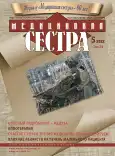Possibilities of combined use of the skin and soft tissues ultrasound and laser doppler visualization in hematoma diagnosis and monitoring in patients with COVID-19
- Authors: Borsukov A.V.1, Gorbatenko O.A.1, Venidiktova D.Y.1, Tagil A.O.1, Borsukov S.A.1, Kruglova A.A.2, Kurchenkova V.S.2, Ahmedova A.R.2
-
Affiliations:
- Smolensk State Medical University the Ministry of Health of the Russian Federation
- Clinical City Hospital No. 1
- Issue: Vol 24, No 5 (2022)
- Pages: 44-49
- Section: Articles
- URL: https://journals.eco-vector.com/0025-8342/article/view/114055
- DOI: https://doi.org/10.29296/25879979-2022-05-08
- ID: 114055
Cite item
Abstract
Full Text
About the authors
Alexey Vasilyevich Borsukov
Smolensk State Medical University the Ministry of Health of the Russian Federation
Email: bor55@yandex.ru
Fundamental research laboratory “Diagnostic researches and minimally invasive technologies”; the Head Krupskoy street 28, Smolensk, Russia, 214019
Olga Alexandrovna Gorbatenko
Smolensk State Medical University the Ministry of Health of the Russian Federation
Email: o.gorbatenkon@gmail.com
Fundamental research laboratory “Diagnostic researches and minimally invasive technologies”.; post-graduate student Krupskoy street 28, Smolensk, Russia, 214019
Daria Yurievna Venidiktova
Smolensk State Medical University the Ministry of Health of the Russian Federation
Author for correspondence.
Email: daria@venidiktova.ru
Fundamental research laboratory “Diagnostic researches and minimally invasive technologies”.; junior scientist Krupskoy street 28, Smolensk, Russia, 214019
Anton Olegovich Tagil
Smolensk State Medical University the Ministry of Health of the Russian Federation
Email: comanton.tagil95@gmail.com
Fundamental research laboratory “Diagnostic researches and minimally invasive technologies”.; junior scientist Krupskoy street 28, Smolensk, Russia, 214019
Semen Alekseevich Borsukov
Smolensk State Medical University the Ministry of Health of the Russian Federation
Email: semen.borsukov99@gmail.com
Fundamental research laboratory “Diagnostic researches and minimally invasive technologies”.; 5-year student Krupskoy street 28, Smolensk, Russia, 214019
Anna Anatolyevna Kruglova
Clinical City Hospital No. 1
Email: kruglowa.anuta@yandex.ru
department of diagnostic and minimally invasive technologies.; internist doctor Frunze street 40, Smolensk, Russia, 214006
Varvara Sergeevna Kurchenkova
Clinical City Hospital No. 1
Email: missis.laricheva@yandex.ru
department of diagnostic and minimally invasive technologies.; the nurse Frunze street 40, Smolensk, Russia, 214006
Alida Rustam kyzy Ahmedova
Clinical City Hospital No. 1
Email: lida.akhmedova@list.ru
department of diagnostic and minimally invasive technologies.; the nurse of the anaesthesiology and intensive care unit Frunze street 40, Smolensk, Russia, 214006
References
- Нагибина М.В., Сычева А.С., Кошелев И.А., и др. Спонтанные гематомы при COVID-19: причины возникновения, клиника, диагностика и лечение. Клиническая медицина. 2021; 99 (9-10): 540-547. https: doi.org/10.30629/0023-2149-2021-99-9-10-540-547
- Кащенко В.А., Ратников В.А., Васюкова Е.Л., и др. Гематомы различных локализаций у пациентов с COVID-19. Эндоскопическая хирургия. 2021; 27(6): 5-13. https: doi.org/10.17116/endoskop2021270615
- Terpos E. et al. Hematological findings and complications of COVID19 American journal of hematology. 2020. 95 (7): 834-847.
- Ashraf O. et al. Systemic complications of COVID-19 Critical Care Nursing Quarterly. 2020. 43 (4): 390-399.
- Анаев Э. Х., Княжеская Н. П. Коагулопатия при COVID-19: фокус на антикоагулянтную терапию Практическая пульмонология. 2020. 1: 3-13.
- Кузнецов М. Р. и др. Основные направления антикоагулянтной терапии при COVID-19 Лечебное дело. 2020. 2: 66-72.
- Руженцова Т. А. и др. Влияние антикоагулянтной терапии на течение COVID-19 у коморбидных пациентов Вопросы вирусологии. 2021. 66 (1): 40-46.
- Тарасенко Г. Н., Карс Ж. Э. Гематома мягких тканей: дерматологическая или косметологическая проблема? Российский журнал кожных и венерических болезней. 2015. 18 (4): 47-48.
- Ashraf O. et al. Systemic complications of COVID-19 Critical Care Nursing Quarterly. 2020. 43 (4): 390-399.
- Rolden F. A. Ultrasound skin imaging Actas Dermo-Sifiliogrificas (English Edition). 2014. 105 (10): 891-899.
- Зубейко К. А. и др. Ультразвуковое исследование кожи (обзор литературы) Радиология-практика. 2014. 6: 40-49.
- Serup J. et al. High-frequency ultrasound examination of skin: introduction and guide. - 2006.
- Венидиктова Д. Ю. Диагностические возможности комплексного ультразвукового исследования кожи Смоленский медицинский альманах. 2016. 1: 53-56.
- Резайкин А. В., Кубанова А. А., Резайкина A. B. Неинвазивные методы исследования кожи Вестник дерматологии и венерологии. 2009. 6: 28-32.
- Бондаренко И. Н. Сравнительный анализ ультразвукового исследования кожи высокочастотными датчиками Радиология-практика. 2021. 6: 22-30.
- Лазюк О. М., Спиридонов В. Е., Саларёв В. В. Актуальность ультразвукового исследования в диагностике заболеваний мягких тканей и кожи Достижения фундаментальной, клинической медицины и фармации. 2014. - С. 36-37.
- Борсуков А. В. и др. Алгоритм дифференциальной диагностики заболеваний кожи с помощью неинвазивной лазерной допплерографии Медицинский алфавит. 2013.1 (10): 20-23.
- Борсуков А. В. и др. Клинические возможности лазерной допплеровской визуализации в терапии и дерматологии Ученые записки Орловского государственного университета. Серия: Естественные, технические и медицинские науки. 2014. 3: 194198.
- Н. А. Лестева и др. Внутримышечные гематомы у пациентов с тяжелым течением COVID-19 (клиническое наблюдение). Общая реаниматология. 2022. 18: 23-30.
Supplementary files










